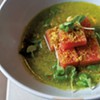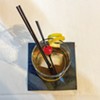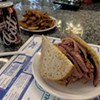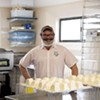Published December 19, 2006 at 9:43 p.m.
Your wannabe-chef sister covets her three Ruth Reichl memoirs and has memorized passages from Anthony Bourdain's Kitchen Confidential. Your uncle - the one who first told you about Eric Schlosser's Fast Food Nation - faithfully followed the Julie-Julia project blog, and now owns the book by Julie Powell. But here's an assortment of other works that can satisfy additional cravings for funny, sensual and sassy food writing. Only one is a new release, but each one's a delicious and satisfying read.
Cupboard Love: A Dictionary of Culinary Curiosities
by Mark Morton
Have you ever been embarrassed by borborygmous? Do you fletcherize your food before you swallow it? The answers to these tongue-twisting questions lie in Mark Morton's Dictionary of Culinary Curiosities. Although it's not comprehensive - common terms such as ladle and tea are absent - the book is stuffed with quirky anecdotes and surprising etymologies.
Unlike the writing in most reference tomes, the prose here is lively and irreverent: Morton calls fondue a "dish/punishment," and in his definition of "chevaline" - horse meat - he writes, "most butcher shops will not even stock chevaline for fear that customers will be so disgusted they will stop buying the other dismembered animals, the ones that it's 'okay to eat.'"
Sometimes Morton is just plain silly, as in the entry on strudel: "Centuries ago, a German sailor would leap out of bed with his heart in his throat if someone on deck shouted these dreadful words: "Mein Gott! Der Strudel! . . ." The fear paralyzing these sailors was evoked not by a chance encounter with the sweet and sticky pastry, but by the natural phenomenon it is named after - the whirlpool."
Despite the goofy nature of certain segments, the book boasts a huge amount of entertaining information, with more than a thousand entries in all.
Caviar: The Strange History and Uncertain Future of the World's Most Coveted Delicacy
by Inga Saffron
Neither salt nor cod has the cachet of caviar. There's something inherently interesting about a food item so luxurious and expensive that you almost forget it's fish eggs. With engaging and sensual prose, Saffron imparts intricate details about the biology of sturgeon and how Russia's complex history impacted the caviar industry.
Early on in the book, she describes a seminal caviar tasting experience: "I rolled the eggs over my tongue, allowing the taut spheres to detonate a few at a time, hoping to harbor the taste for as long as possible. The salty-buttery richness filled my mouth, nuclear in its intensity. New and different tastes came in explosive bursts, as the initial fishiness gave way to more complex flavors and aromas. I was reminded of other rich foods - olives, pine nuts, smoked salmon. But it was the physical sensation, the way the firm casings of the eggs gave way as they popped against my tongue and cheek that dominated the experience."
One of the best things about the book is that it increases awareness of the ecological abuses inherent in the caviar industry without dosing out guilt to caviar lovers. Saffron, who is clearly an enthusiast herself, focuses on solutions that every fish-egg aficionado can participate in, rather than castigating those who enjoy it in the first place.
Best Food Writing, series edited
by Holly Hughes
Each year around the holidays, a new Best Food Writing anthology appears on the shelves - and, hopefully, under my Christmas tree. These volumes pull essays and articles from many sources, including culinary magazines, newspapers and, occasionally, the Internet. Stories range from beautifully descriptive odes on favorite foodstuffs to gut-wrenching exposés.
In her brief article "A Question of Taste," which appears in the 2005 edition, Monica Bhide writes lyrically of the Hindu taboo against tasting a dish before offering it to the gods. Instead she developed her other senses. "I had learned to cook by sight, smell, sound and texture . . . My mother taught me to make curries by hearing how onions sing in oil, from a slight sizzle to a glorious harmony as they get perfectly caramelized. I learned to watch the tomatoes marry the onions."
In the same collection is a brutal story called "Killing Dinner" by Gabrielle Hamilton, chef at New York's Prune. The moral of Hamilton's tale is: "There are two things you should never do with your father: learn how to drive, and learn how to kill a chicken." She uses painfully precise language to describe the experience: "It's quite something to go barehanded up through a chicken's ass and dislodge its warm guts. Startling, the first time, how fragilely they are attached."
The 2006 edition of Best Food Writing, which weighs in at 352 pages, is organized into bite-sized chapters such as "Home Cooking," "Baking Up a Storm" and "The Restaurant Biz." The Man Who Ate Everything by Jeffrey Steingarten
The Man Who Ate Everything
by Jeffrey Steingarten
Unabashed passion meets uncensored snark in this first collection of essays by Jeffrey Steingarten. A graduate of Harvard Law, he ceased practicing when he accepted a job as the food writer for Vogue magazine in 1989. Since then, Steingarten has been on a merry romp through the world of gastronomy, debunking myths and pursuing perfect recipes as he goes.
In the book's introduction, Steingarten explains his initial concern over accepting the position at Vogue. "As I considered the awesome possibilities of my new post, I grew morose. For I, like everybody I knew, suffered from a set of powerful, arbitrary, and debilitating attractions and aversions at mealtimes. I feared I could be no more objective than an art critic who detests the color yellow." And so he bravely set out to conquer his culinary quibbles and become "a perfect omnivore."
Once he achieves that status - overcoming a strong distaste for clams, kimchi, Greek food and anchovies - Steingarten embarks on a series of culinary experiments. In one, he attempts to identify the perfect ketchup via a "scientific" tasting: He purchases 33 ketchups and then agonizes over the perfect tasting vehicle. "I was worried that eating thirty-three hamburgers in a row would be impractical, as was, I would soon discover, cutting a single hamburger into thirty-three equal wedges."
The solution? Ten large orders of McDonald's fries.
What Steingarten does best is integrate detailed scientific and cultural information into what is otherwise a wryly hilarious commentary. In his search for an ideal ketchup, he saucily expounds on the origin of the condiment, how to make it, how many bottles Americans consume each year, and other vital statistics.
Other articles include Steingarten's experiences on varied fad diets, an attempt to cook only with recipes "from the back of a box" and a treatise on the dangers of uncooked vegetables that would make any raw foodist shudder - a result that no doubt would please him immensely.
The Art of Eating
by M.F.K. Fisher
M.F.K. Fisher is considered one of the premier food writers of the 20th century, but her emotional life was a roller coaster. She divorced her first husband to marry a mutual friend - her "soul mate" - only to have him die in under two years. Later, as a single mother, she struggled to provide for two daughters. Through it all, she documented her experiences as they related to food and dining.
Five of Fisher's most famous works are collected in this single volume. One of them, How to Cook a Wolf, was written in 1942 during the rationing and shortages of World War II. In it, Fisher advises on how to eat economically without spiritual depravation. "You can still live with grace and wisdom," she says, encouraging such tricks as "steeping parsley stems in hot water" to be mixed with tomato juice so as not to waste the parsley, and adding bread crumbs to scrambled eggs to "stretch them."
The writing is formal yet intimate in her memoir The Gastronomical Me. Of a special holiday, she writes: ". . . there was a present for me on the low table, the prettiest Easter present I have ever seen. It was a big tin of Beluga caviar . . . and all around the tin and then the edge of the plate were apple blossoms. I think apple blossoms are perhaps the loveliest flowers in the world, because of their clarity and the mysterious way they spring so delicately from the sturdy darkness of the carved stems . . ."
Fisher crossed the Atlantic - by boat - to inform her first husband she wanted a divorce. En route, she wrote, "I preferred to eat by myself, slowly, voluptuously, and with an independence that heartened me against the coldness of my cabin and my thoughts."
Besides the two works already mentioned, The Art of Eating includes Serve It Forth, Consider the Oyster and An Alphabet of Gourmets.
More By This Author
Speaking of Food, books
-

Q&A: Howard Fisher Delivers Meals on Wheels With a Side of Good Cheer
Dec 20, 2023 -

Video: Howard Fisher Delivers Meals on Wheels
Dec 14, 2023 -

Q&A: Alexis Dexter Rescued 57 Shelter Cats During the July Flood
Sep 13, 2023 -

Video: Two Months After the Flood, Alexis Dexter Rebuilds Kitty Korner Café in Barre and Continues to Rescue Cats
Sep 7, 2023 -

Vermont Book Award Winners Announced
May 6, 2023 - More »
Comments
Comments are closed.
From 2014-2020, Seven Days allowed readers to comment on all stories posted on our website. While we've appreciated the suggestions and insights, right now Seven Days is prioritizing our core mission — producing high-quality, responsible local journalism — over moderating online debates between readers.
To criticize, correct or praise our reporting, please send us a letter to the editor or send us a tip. We’ll check it out and report the results.
Online comments may return when we have better tech tools for managing them. Thanks for reading.













































